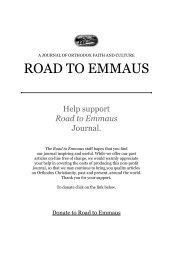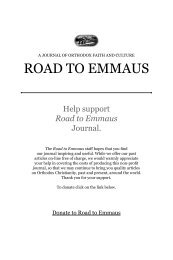RTE No 20 Interior - Road to Emmaus Journal
RTE No 20 Interior - Road to Emmaus Journal
RTE No 20 Interior - Road to Emmaus Journal
Create successful ePaper yourself
Turn your PDF publications into a flip-book with our unique Google optimized e-Paper software.
<strong>Road</strong> <strong>to</strong> <strong>Emmaus</strong> Vol. VIII, <strong>No</strong>. 4 (#31)FAITH UNSEEN<strong>to</strong>ry, this simple woman had no way of knowing the his<strong>to</strong>rical events of thesix generations from “the change” around 1650, when the Pontic cryp<strong>to</strong>-Christians first appeared, until they were able <strong>to</strong> declare themselves <strong>20</strong>0years later. Even now, in the areas of Ofi (Of) and Thoania (Tonya), theMuslims speak Roméika as their mother <strong>to</strong>ngue, and they call the period ofRamadan Triod (i.e. Triódion, the Greek for the three-ode canons sung duringGreat Lent).An absolute majority of Kromeans were cryp<strong>to</strong>-Christian. Among themwere local people of distant Persian descent who had also become Christian,and a few foreign technical specialists for the mines. We know of these foreignersbecause of the area called Frangandon (Europeans were called“Frangos” in the local language, and surnamed after their nationality, suchas “Germanides.”)Mullah Molasleyman was ordained an Orthodox priest by Dorotheos III,Archbishop of Trebizond (1764-1790), after his return <strong>to</strong> Varenou in 1782. 6Although the area of Kromni belonged <strong>to</strong> the Metropolis of Chaldia, thecryp<strong>to</strong>-Christians of Kromni were under the Metropolis of Trebizond forsecurity. The Chaldian diocesan headquarters in Argyroupoli was <strong>to</strong>o smalland close for frequent contact <strong>to</strong> go unnoticed, but Trebizond was a largecity, 1<strong>20</strong> kilometers away.It was not uncommon for an Orthodox cryp<strong>to</strong>-Christian priest <strong>to</strong> also actas the local mullah in cryp<strong>to</strong>-Christian communities. He was often the onlyeducated person who could speak and read Turkish, Arabic, and ecclesiasticalGreek (enough for the services), as well as Roméika. If the village was allcryp<strong>to</strong>-Christian and very isolated, the cryp<strong>to</strong>-Christian priest did not have<strong>to</strong> pretend <strong>to</strong> be a Muslim mullah, he was simply known <strong>to</strong> the outside worldas a simple Muslim. But if the village was larger or had enough of a Muslimpopulation <strong>to</strong> have a Turkish gendarme, the priest was also often the mullah,which added <strong>to</strong> the security of the cryp<strong>to</strong>-Christians. If a cryp<strong>to</strong>-Christianacted as mullah, he was also the defac<strong>to</strong> leader of the Muslim community,and would know immediately if there was a threat against the Christians.This had <strong>to</strong> be, because what explanation could a village give for not havingMuslim religious services? Even if they had no real Muslims in the village,6 Ed. <strong>No</strong>te: It is tempting <strong>to</strong> speculate that Mullah Molasleyman may not only have been ordained byArchbishop Dorotheos III, but was perhaps sent by him <strong>to</strong> Constantinople/Istanbul as a youth for trainingas a mullah, foreseeing that the well-being of Kromni’s cryp<strong>to</strong>-Christians depended on his fulfilling the dualroles of mullah and priest. If not sent, he certainly <strong>to</strong>ok on the outward role of a Muslim clergyman with thearchbishop’s blessing.they had <strong>to</strong> have someone official <strong>to</strong> show when the authorities came around,because outwardly they were Muslim. If there was no local mullah, who wasalso one of them, it would have been a terrible problem.In Mullah Molasleyman’s village of Varenou, surprisingly, there was nomosque or even a simple camii, the open-air platform set aside for Muslimprayers in villages that could not afford <strong>to</strong> build a mosque. The villagers ofVarenou always <strong>to</strong>ld visiting Turkish officials, “We are <strong>to</strong>o poor <strong>to</strong> build amosque, but we will try <strong>to</strong> gather the money <strong>to</strong> build a camii.” The camii wasnever built.Festal Cus<strong>to</strong>ms: Theophany Eve and the Church New YearMy grandmother used <strong>to</strong> say, “As secret Christians, we were more strict thanthe open Christians. We kept every feast and every tradition.” The feastswere celebrated with absolute secrecy, the fasts kept with great solemnity,and liturgy and Holy Communion <strong>to</strong>ok place with the fear of God. Greatchurch feasts were celebrated much as they are now, but I will mentionsome cus<strong>to</strong>ms that have disappeared in our times.A deeply moving tradition <strong>to</strong>ok place on the eve of Theophany. The familygathered in the underground chapel where, on a small table, they placeda bowl of wheat and corn in<strong>to</strong> which they put lit candles, each candle dedicated<strong>to</strong> a dearly deceased member of the family. The last candle was lit forthe unknown dead, for those who had no one <strong>to</strong> commemorate them. Thesmall dark church was lit only by these candles, and the family remainedthere, with the priest or head of the family offering the prescribed prayersand chants until the last candle melted.Each year on the 1st of September, the Church New Year, from beforedawn the priest visited the homes of all of the cryp<strong>to</strong>-Christians, sprinklingeach house and its residents with holy water. This was a very old cus<strong>to</strong>m,older than Christianity itself, as the ancient Greeks also consideredSeptember 1st the first day of the new year.Another very moving cus<strong>to</strong>m was the quiet walk of a secret priest throughthe village streets <strong>to</strong> the house of a dying Christian. Under his clothes, he heldthe chalice with Holy Communion. If someone saw the priest and greetedhim, he would not answer, but continued on his way in silence. <strong>No</strong> one misunders<strong>to</strong>od.The priest’s silence always meant that he was visiting the dying.1617










